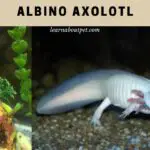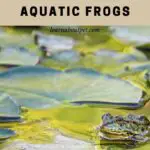Having an exotic aquatic pet will feel more challenging if we have more than one. The axolotl is one of the best choices for aquatic pet owners because of its uniqueness and is classified as critically endangered.
Many want to take care of them to provide a happy life rather than axolotls having to survive in their natural habitat, which is starting to disappear. Sometimes caring for one axolotl is not enough.
Can you put two Axolotls together? Axolotls are solitary animals and prefer to be alone in a tank. Axolotls do not need friends because they are also not a social species. But you can put two axolotls in one tank if they are the same size.
If one axolotl is bigger and can fit into the other axolotl’s mouth, the change in eating smaller axolotl will be high.
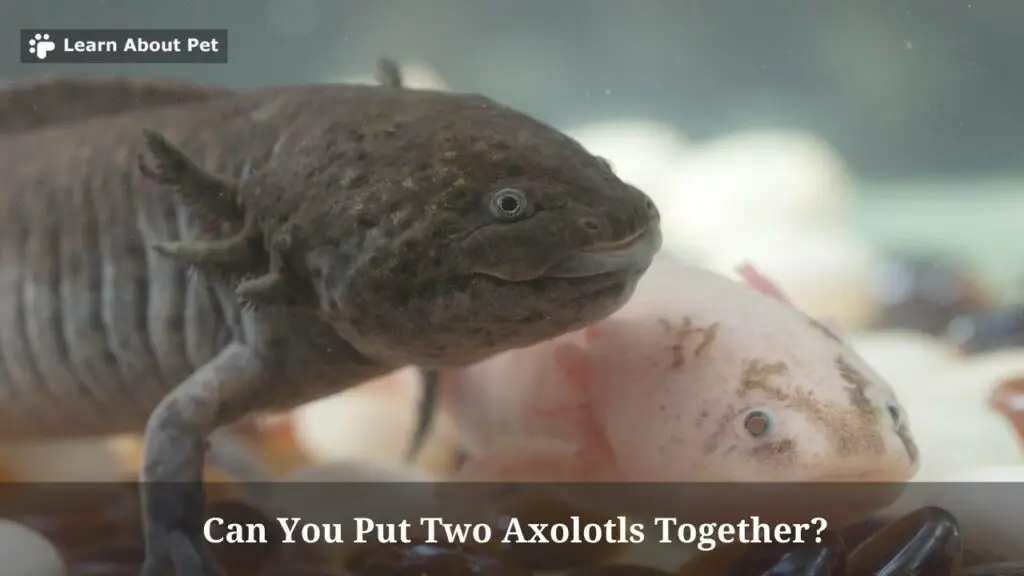
Having axolotls is fun, but you must understand what if you put more than one axolotl in a tank. Let’s read this article to the end.
Can You Have More Than One Axolotl In A Tank?
Having more than one axolotl in one tank is acceptable if you know the rules. You need to provide enough space for each axolotl. If axolotls cannot move freely and eat in private, they will be stressed and affect their health.
Axolotls under stress can behave aggressively and attack other axolotls. If you have a 10-gallon tank, don’t put more than 2 axolotls because the space is narrow if 2 axolotls are full-grown. More recommended axolotl to be kept alone. They will never feel lonely, even if you put them in a tank with just plants or rocks.
Can You Put Two Axolotls Together?
Yes, you can, but in specific conditions. You must measure how much space the axolotl takes up in the tank. A large tank, per axolotl, requires at least a 20-gallon tank with the possibility of full-grown size. If you want to put two axolotls, you have to put them in a 40-gallon tank.
The bigger tank will ensure each axolotl has its place to swim and spend time. If the tank is too narrow, the axolotls can meet frequently, and one axolotl can act aggressively. Bigger tanks also make it easier for you not to make water changes too often.
Can You Put Two Baby Axolotls Together?
You can put several baby axolotls in the tank, provided you have to provide enough food each time. Growing babies can be aggressive if they lack food. Babies need a lot of calories for their growth. Axolotls need to eat much more from baby to post-adult than adults.
If axolotls don’t get the calories they need, they can eat other babies, including their siblings, or fish that are smaller than them. The underfeeding babies will be seen nipping each other. An axolotl that is injured will attract other axolotls by its smell. The baby’s axolotl can lose their fingers, gills, or limbs.
When Can You Put Axolotls Together?
Try putting them in the same tank, but put a tank divider and leave it for a week until both axolotls can see each other. When they have their hiding place and plenty of space to swim, it won’t be a big problem. Meet them and see how they are in the same tank.
If one axolotl shows an aggressive attitude, you must separate it again by placing a tank divider or moving it to another tank.
Can you put two Axolotls together? Letting the axolotl live alone in the tank is the best move. If you want to put two axolotls, ensure they are the same size and that the tank you are using is bigger than their needs.
What Size Tank Do I Need For 2 Axolotls?
Housing for two axolotls is 61cm or larger. This measure ensures that both axolotls have exercise, hiding places, and swimming around. Look at the behavior of the two axolotls while in the tank. If one axolotl floats, refuses to eat or is unresponsive, it is a sign that the axolotl is under stress.
Axolotl’s size should be the same, and you should pay attention to how much each axolotl eats. Do not let one axolotl still be hungry because axolotls can be nipping their tankmates and lead to other aggressive actions.
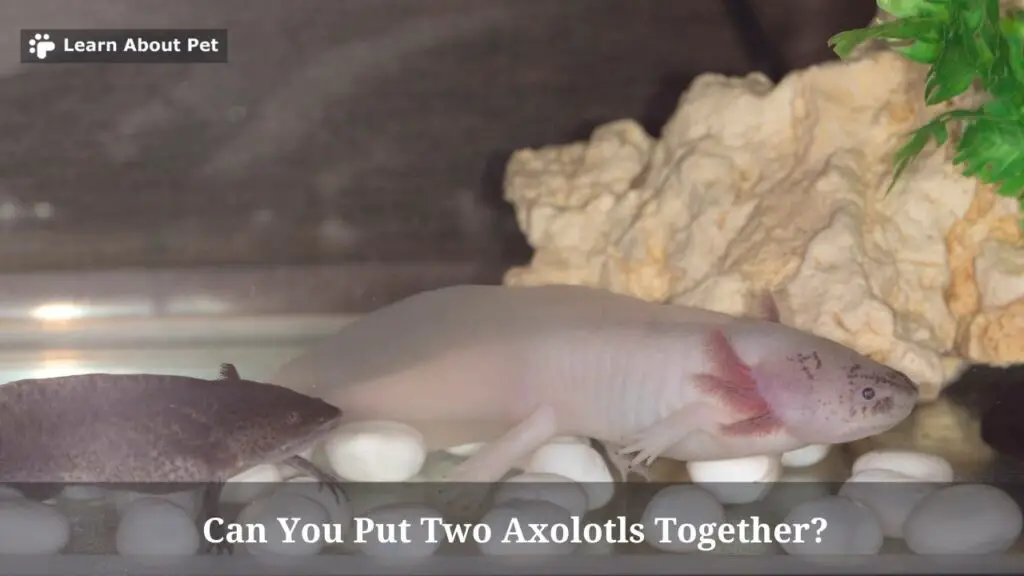
Can I Add Another Axolotl To My Tank?
It depends on how big the tank you have. First, both axolotls must be the same size. Next, you must quarantine the new axolotl for at least 7 days before placing it in the same tank as the old axolotl. Let the two axolotls look at each other in different tanks until they can recognize each other’s characteristics.
Don’t let your guard down in the first few days after putting the new axolotl in the tank. Watch until both axolotls do nothing to the other axolotl. Recognize how the axolotl’s behavior when stressed because of being intimidated by something, and prevent that from happening.
Can Axolotls Live In Pairs?
Axolotl doesn’t matter if it wants to live in pairs. They are more comfortable living alone in a tank, but there can be other axolotls as long as their size is not much different. Don’t get another one if you are still unable to provide food that meets the needs of one axolotl.
Having an axolotl must meet several requirements, such as water hardness, water pH, daily diet, and large tank. If you still can’t get the axolotl to live a healthy and happy life, don’t add one or more axolotls to the same tank.
Can 2 Axolotls Live Together In A 20 Gallon Tank?
A 20-gallon tank is a proper size for one axolotl. If you are forced to put two axolotls in a 20-gallon tank, then both axolotls will get stressed easily because they don’t have enough room to exercise or play around.
The 10-gallon tank is the minimum space for each axolotl. If you have adult axolotls in a 10-gallon tank, they will get bored easily and act aggressively. There are several signs that axolotls show when they are stressed:
| Stressed axolotl | Explanation |
| Curled gills | Unhappy axolotl will show curled gills towards the face. The reason is that the water parameters do not match the axolotl’s needs. |
| Curled tail | Axolotl stress due to illness. Check the tank whether the nitrogen cycle is not good or there is an ammonia spike. |
| Loss appetite | The axolotl doesn’t want to go near its food even if you give it live food. |
| Floating | Axolotl looks floating upside down with a lot of water gulping. Try checking for ammonia or nitrite spikes. |
Can Axolotls Prey On Each Other In The Same Tank?
It depends on how much you feed each axolotl. If there is one axolotl that lacks food, then they can nip others or plants in the tank. Axolotls need to be fed until they refuse it. A sign that axolotls are full is to refuse live food even if it is near them. If you give food and the axolotl still eats it, then that’s a sign that the axolotl is still hungry.
Can you put two Axolotls together? As long as they have the same size and you can give them enough space to swim, then it will not be a big problem for both of them.
Is It Recommended To Put Only 1 Axolotl In One Tank?
Yes, because axolotls are solitary animals. Axolotl will not get bored even if you put it in a tank from baby to adult. Axolotls can be aggressive towards smaller fish or other axolotls and can make them prey.
Final Verdict – Can You Put Two Axolotls Together
Axolotls need a large amount of space to pass the time and maintain their health. Per axolotl requires a 20-gallon tank for swimming, exercise, hiding, and a private place to eat. If you want to put two axolotls in one tank, you’ll need a 40-gallon tank or more.
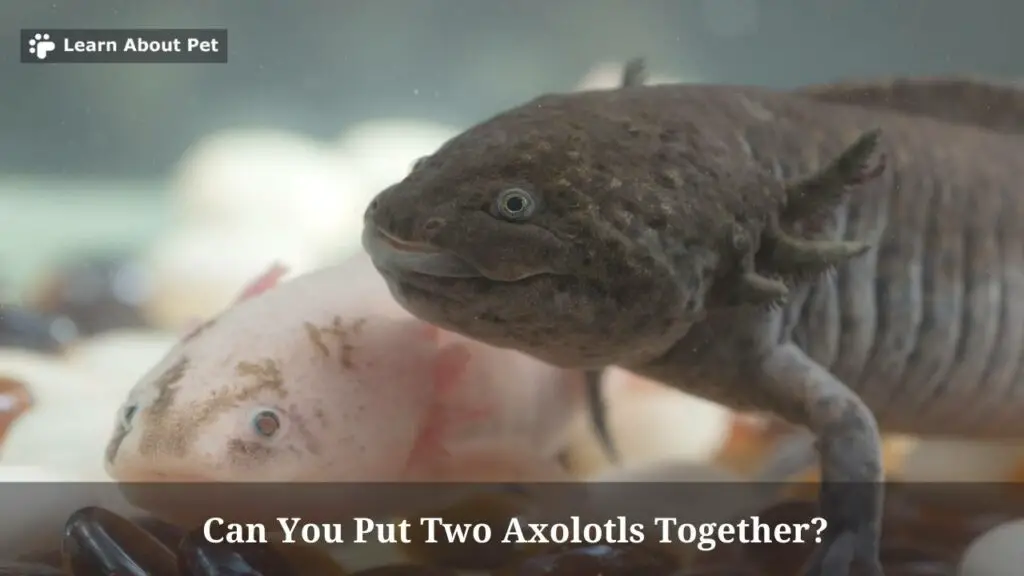
The large space will ensure that each axolotl has its own space and doesn’t run into each other often. Don’t starve the axolotls, because underfed axolotls can act aggressively on other axolotls.
As a pet lover, make sure to learn about pet more and give your pet axolotl a good and comfortable life!

Welcome to Learn About Pet. My name is Rajkumar Ravichandran and I love all pets, travel, and amazing food. I write about my passion and personal experience caring for multiple pets in this blog! ❤️
Post Disclaimer
DISCLAIMER: THIS BLOG OR WEBSITE, "Learn About Pet", DOES NOT PROVIDE YOU WITH MEDICAL ADVICE AND IS NOT A SUBSTITUTE FOR MEDICAL ADVICE. ALWAYS GET IN TOUCH WITH YOUR PERSONAL VETERINARIAN AND USE INFORMATION HERE AS GENERAL ADVICE.
The information, including but not limited to, text, graphics, images and other material contained on this website are for informational purposes only. No material on this site is intended to be a substitute for professional veterinary advice, food recommendation, diagnosis, or treatment. Always seek the advice of your veterinarian or other qualified health care provider with any questions you may have regarding a medical condition or for pet food related questions.


